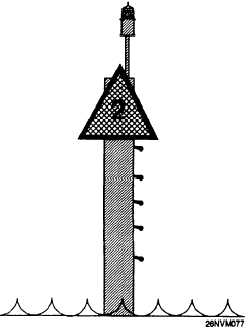| |
Types of Lights and Light Structures, Continued
Daybeacons
There are many ATONs that are not lighted, especially in the inland
waters of the United States. Structures of this are called daybeacons
(fig. 4-7). They are not buoys, but are permanently mounted in position.
Daybeacons vary greatly in design and construction, depending on their
location and the distance from which they must be seen. A daybeacon
may consist of a single pile with a daymark on the top, a multi-pile
structure, a tower, or a structure of masonry or steel. Daybeacons are
fitted with reflecting tape to facilitate their identification by searchlight
at night. Daymarks marking the sides of channels are colored and
numbered in the same manner as buoys, with red even-numbered marks
indicating a starboard-side channel boundary and green odd-numbered
marks on the portside channel boundary. The shapes for channel,
preferred-channel, nonlateral, and safe-water daymarks, together with
their chart symbols, are shown in chart No. 1 and on plate 1.
Minor Lights
Just as daybeacons are sometimes
substituted for unlighted buoys,
lighted buoys are often replaced by
minor lights (fig. 4-8). Minor lights
are fixed structures of the same
overall physical features as
daybeacons, but are equipped with
lights generally similar in
characteristics to those found on
buoys. Minor lights can be used in
a series with other aids to mark
channels, rivers, or harbors and can
be used to mark some isolated
areas.
The term minor light does not
include the more important lights
marking harbors, peninsulas, major
shoals, and so on, which have lights
of greater intensity and/or special
Figure 4-8. Minor light.
characteristics and were discussed earlier in this manual. Daymarks are
placed on the structures for identification, and reflective material is
added for nighttime safety in case the light is extinguished. A minor
light normally has the same color, flash, and phase characteristic as that
of a lighted buoy. Intensity of the light is generally of the same order as
that of a lighted buoy, but visibility may be increased by its greater
height above water.
4-18
|

